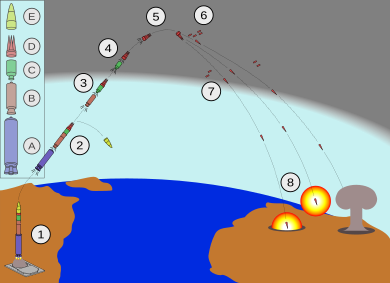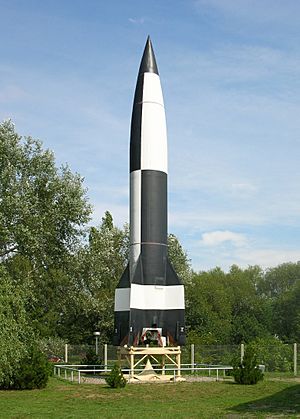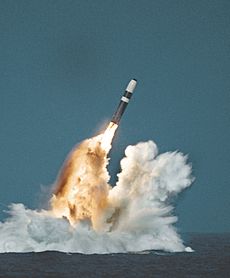Ballistic missile facts for kids
A ballistic missile is a powerful rocket that flies in a special arc, like a thrown ball, to deliver a payload to a target. It's only powered for a short time at the start. Most of its journey is unpowered, just gliding through the air or space. Smaller ones stay within Earth's air, but bigger ones go high into space. The biggest ones, called ICBMs, can even go almost all the way around the Earth. Ballistic missiles are different from cruise missiles, which fly like airplanes and are powered throughout their flight.

- 1. The missile launches out of its silo by firing its 1st-stage boost motor (A).
- 2. About 60 seconds after launch, the 1st-stage drops off and the 2nd-stage motor (B) ignites. The missile shroud (E) is ejected.
- 3. About 120 seconds after launch, the 3rd-stage motor (C) ignites and separates from the 2nd stage.
- 4. About 180 seconds after launch, 3rd-stage thrust terminates and the post-boost vehicle (D) separates from the rocket.
- 5. The post-boost vehicle maneuvers itself and prepares for re-entry vehicle (RV) deployment.
- 6. The RVs, as well as decoys and chaff, are deployed.
- 7. The RVs (now armed) and chaff re-enter the atmosphere at high speeds.
- 8. The nuclear warheads detonate.
Contents
The History of Ballistic Missiles

The idea of rockets has been around for a long time. But the first modern ballistic missile was the A-4, better known as the V-2. It was developed by Nazi Germany in the 1930s and 1940s. A scientist named Wernher von Braun led this project.
The V-2 was first successfully launched on October 3, 1942. It started being used in combat on September 6, 1944, when it was fired at Paris. Two days later, it attacked London. By the end of World War II in Europe in May 1945, over 3,000 V-2 rockets had been launched.
After World War II, countries like the Soviet Union and the United States continued to develop these missiles. The R-7 Semyorka was the first intercontinental ballistic missile (ICBM), meaning it could travel very long distances between continents.
How Ballistic Missiles Fly
A ballistic missile's flight has three main parts:
- Powered flight: This is when the rocket engines are firing. It can last from a few seconds to several minutes. During this time, the missile gains a lot of speed and height. Some missiles use multiple rocket stages, where parts of the rocket fall off after their fuel is used up.
- Free flight: Once the fuel runs out, the engines stop. The missile then glides freely through space or the upper atmosphere. This is the longest part of the flight. For very long-range missiles, they can reach altitudes of about 4,500 kilometers (2,800 miles) during this phase.
- Re-entry: This is when the missile starts to fall back into Earth's atmosphere. As it enters the thicker air, it slows down due to air resistance. It travels very fast, often between 6 to 8 kilometers per second (about 13,400 to 17,900 miles per hour) for ICBMs.
Ballistic missiles can be launched from many places. They can come from fixed sites on land, or from mobile launchers like special trucks. They can also be launched from aircraft, ships, or even submarines.
Different Types of Ballistic Missiles
Ballistic missiles come in many sizes and can travel different distances. They are often grouped by how far they can go:
- Air-launched ballistic missile (ALBM): These are launched from airplanes.
- Tactical ballistic missile: These have a shorter range, from about 150 to 300 kilometers (93 to 186 miles).
- Theatre ballistic missile (TBM): These can travel from 300 to 3,500 kilometers (186 to 2,175 miles). This group includes:
* Short-range ballistic missile (SRBM): Range from 300 to 1,000 kilometers (186 to 621 miles). * Medium-range ballistic missile (MRBM): Range from 1,000 to 3,500 kilometers (621 to 2,175 miles).
- Intermediate-range ballistic missile (IRBM): These have a range from 3,500 to 5,500 kilometers (2,175 to 3,418 miles).
- Intercontinental ballistic missile (ICBM): These are the longest-range missiles, traveling more than 5,500 kilometers (3,418 miles). They can go from one continent to another.
- Submarine-launched ballistic missile (SLBM): These are launched from special submarines called SSBNs.
Longer-range missiles are usually designed to carry nuclear weapons. This is because their payload is too small for regular explosives to be as effective as bomber aircraft.
Quasi-Ballistic Missiles
A quasi-ballistic missile is a type of short-range ballistic missile that can do special maneuvers during its flight. This means it can change direction or range in unexpected ways. This makes it harder to predict where it will land. Some large guided rockets, like those used in multiple launch rocket systems, are sometimes called quasi-ballistic missiles.
Hypersonic Ballistic Missiles
Many ballistic missiles reach hypersonic speeds (which is more than 5 times the speed of sound) when they re-enter the atmosphere. However, in military terms, a "hypersonic ballistic missile" usually refers to one that can be steered and maneuvered even after it has re-entered the atmosphere, instead of just following a simple arc. This makes them very difficult to stop.
Ballistic Missiles Used in Combat
Here are some ballistic missiles that have been used in real combat situations:
- 9K720 Iskander
- Ababil-100
- Al-Samoud 2
- DF-12
- Fateh-110
- Ghadr-110
- LORA
- MGM-140 ATACMS
- OTR-21 Tochka
- Qaher-1/2M
- Scud
- Toufan (a version of the Iranian Ghadr-110)
- V-2
- Zolfaghar
- Kh-47M2 Kinzhal
See also
- Ballistic missile flight phases
- Missile (guided)
- MIRV
- NATO reporting name (has lists of various Soviet missiles)
- Surface-to-surface missile
- Weapons of mass destruction
- List of currently active missiles of the United States military
- List of ICBMs
- List of missiles
- List of missiles by nation
- List of NATO reporting names for ballistic missile submarines



